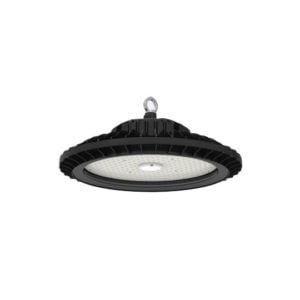Warehouse lighting is designed to provide an optimal combination of visibility and volume – perfect for warehouses, industrial centers and other settings that call for bright, reliable fixtures.
Almost all large warehouses rely on high bay lights or low bay lights to provide general illumination. LED high bay and low bay lights are the gold standard for their energy efficiency, performance, uniformity, reliability and controllability.
In addition to low and high bays, warehouses also install exit lighting and emergency lights for safety and visibility reasons when the primary lighting system experiences an outage. For maximum reliability, LEDs are the preferred option for emergency and exit lighting solutions.

Selecting LED High Bay and Low Bay Lights for a Warehouse
Bay lighting is the frontline lighting solution for warehouses and other large interior commercial or industrial spaces. There are a few fixture options to choose from, including:
- Low bay lights – Low bay fixtures are designed for warehouses with lower ceilings (between 12 and 20 feet high). Low bay lights tend to consume less power (under 100 watts) and output less illumination than high bay fixtures given their application in lower ceiling warehouses.
- High bay lights – High Bay fixtures are intended for warehouses with higher ceilings (between 20 and 40 feet high). Given the extra space that high bays must illuminate, they are designed to output higher levels of brightness, which means they consume more power than low bay lights.
- Linear bays – Linear bay lights are rectangular-shaped and emit illumination in a similar pattern. Their design means linear bays are ideal for lighting warehouse aisles and other corridor-like spaces.
- Circular (UFO) bays – UFO bay lights are circular in shape and are therefore designed to illuminate open spaces. UFO bays are the first choice in general warehouse and store lighting, as they are better at filling up a room with light.
It is common to see a mix of linear and UFO bays in a single warehouse, installed where their distribution patterns make the most sense.
The Benefits of LED Warehouse Lighting
Traditionally, bay lights and other warehouse lighting solutions were powered by metal halide or fluorescent lighting technology. However, the rise of LED lighting solutions has pushed those outdated technologies to the bottom of the list. LEDs are now considered the top lighting option in a variety of applications, including warehouse lighting applications.
There are several reasons why LED bay lights are now the most common lighting solution in warehouses, including:
- Superior energy efficiency – LED lights are the most energy efficient on the market, achieving lumen-to-watt ratios that exceed metal halide and fluorescent lights. This is especially true at the system level, where LED’s directionality and controllability improve overall efficiency.
- Reduced maintenance overhead – LED lights are designed to last much longer than previous fixture technologies. A metal halide may only provide 10,000 hours of illumination and fluorescent tube only 20,000 hours. By contrast, an LED light provides 50,000 or more hours of high-quality illumination. That means fewer replacements and lower maintenance costs.
- Better performance – Modern LED lights emit more illumination with greater uniformity and perceived brightness, compared to older lighting technologies. LEDs also render color better than other warehouse lights, which improves long-range visibility and safety for warehouse workers.
- Better controllability – LED lighting solutions are compatible with all types of lighting controls, including timers, photocells and occupancy controls. Lighting controls can be paired with a warehouse lighting system to improve energy efficiency further and to ensure there is always adequate illumination wherever workers are active. Occupancy controls can also be paired with LED lights for security lighting purposes.
Why Photometric Analysis is Recommended for Warehouse Lighting Solutions
Warehouse lighting systems are large-scale, high-volume lighting solutions that come with a significant investment. Understandably, your organization will want to maximize the value from its warehouse lights. Photometric analysis is a proven way to do so.
During photometric analysis, a lighting designer will model your project space (the inside of your warehouse, for example) and model a variety of potential lighting solutions. Photometric analysis software is extremely sophisticated and can provide down-to-the-lumen calculations for every square foot of your property – so you will know exactly how much light will illuminate the facility.
Photometric software uses lighting data direct from the manufacturer, so the results are precise and accurate. With photometric analysis services, your lighting installer will be able to pick the most energy efficient LED lights for your space, without compromising on system performance or safety.
Warehouse Lighting with Photometric Analysis Provides Optimal Visibility, Safety and Efficiency
LED warehouse lighting systems output tens of thousands of lumens with excellent efficiency and long-term value. They operate optimally when installation is guided by photometric analysis and expert insight.
If your organization has large facilities, including warehouses, consider partnering with an experienced commercial lighting company to source and install your bay fixtures. By doing so, your company will have access to best lighting practices and products.







